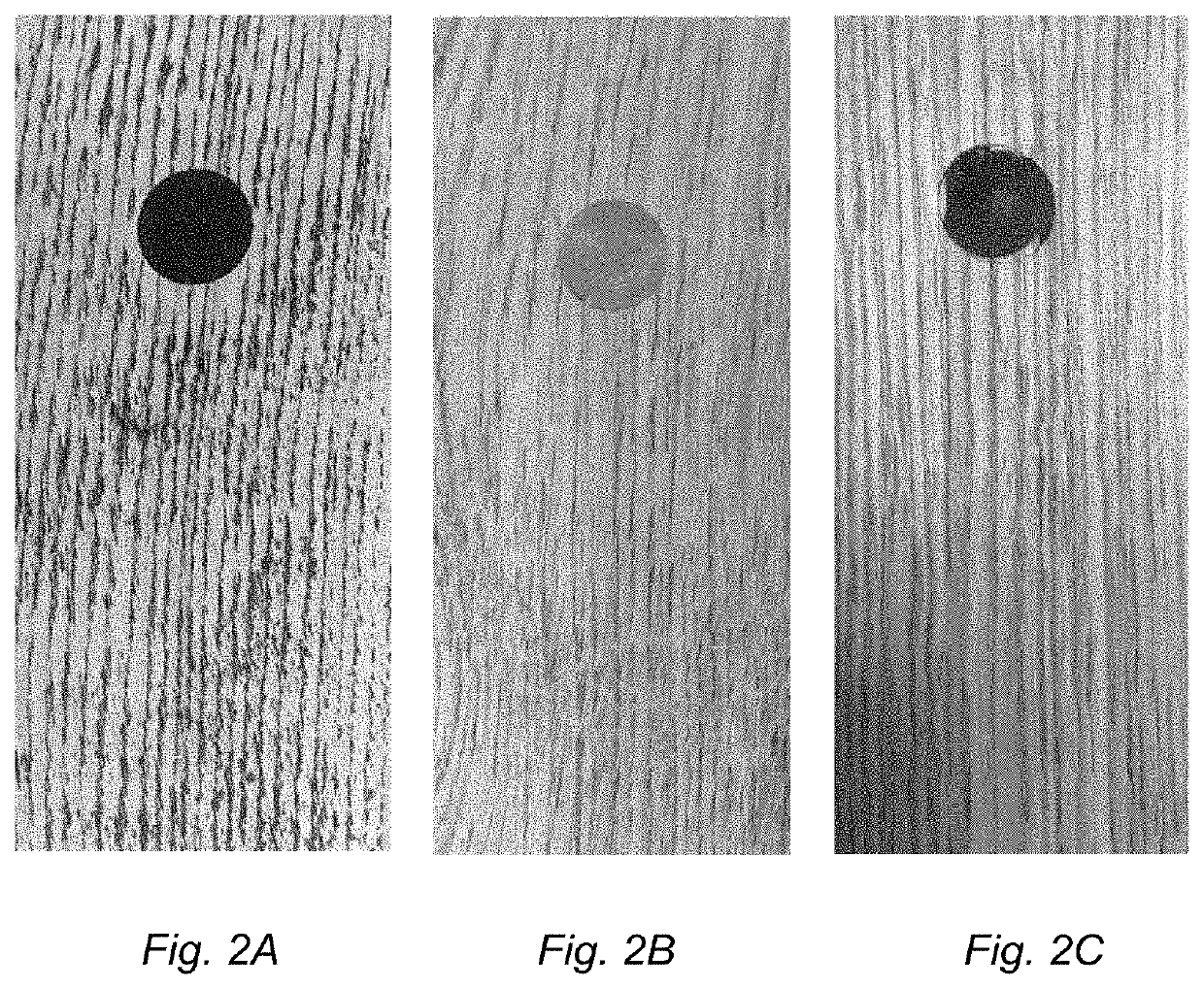Method to produce a veneer element and a veneer element
a technology of veneer elements and elements, applied in the field of methods to produce veneer elements, can solve the problems of poor aesthetic appeal to consumers, incomplete homogeneous structure and appearance of veneer elements, and defects in veneer elements, and achieve the effect of improving the visual impression of the veneer layer after pressing
- Summary
- Abstract
- Description
- Claims
- Application Information
AI Technical Summary
Benefits of technology
Problems solved by technology
Method used
Image
Examples
example 1
Testing of Various Filler Materials
[0172]Several dark coloured filler materials, listed as additives 1 to 11 (Table 1), were selected because of their different properties, material classes and varying shape and size. However, the size was still within the desired particle range for this application of at least 0.1 μm in diameter.
TABLE 1Coloured filler particles used.ParticleNo.Additive nameMaterial classcharacteristic1Petrit TMetallic / ceramic blendPowder2Petrit T-SMetallic / ceramic blendGranules3MT-1Metallic with highPowdercarbon content4Brown pelletsOrganicGrinded to fibrouspowder5Coffee (coarse)OrganicGrinded coarsely topowder6Coffee (Fine)OrganicGrinded finely topowder7Distaloy AEMetalWater atomized ironpowder alloy8Arbocel SpheresOrganicSpherical granulate(black)9Vitacel AF-401OrganicFibrous powder(apple fibre)10Cocoa fibreOrganicFibrous powder11BarkOrganicPowder12Heat treatedOrganicFibrous powderSonae 30013Dyed Sonae 300OrganicFibrous powder
[0173]Additive with number 13 in Tabl...
example 2
[0183]Following was performed in order to prove that fine particles of a size less than 0.1 μm, such as free pigments in the formulation are easily carried by the melamine formaldehyde resin melt flow when applying heat and pressure. On the contrary, coarse particles of the size at least 0.1 μm in diameter e.g. dark coloured filler particles like a burned Sonae 300 fibre or a grinded brown pellet would have the binder separate from the solid loading under when melting under heat and pressure. Pucks were formed from different powders, comprising a melamine-formaldehyde resin, wood fibre, and either pigments or dark fillers. These pucks were then cured under heat and pressure, where the binder would, in case of separation from the solid phase create a transparent rim of the pressed puck, whereas this rim would be opaque if the coloured solid loading was carried by the melt phase.
TABLE 6Colouring agents used in Example 2.SampleColouring additive1Printex 60 (pigment)2MT-1 (colour filler...
example 3
[0186]The scope of this experiment was to evaluate how particle size, characteristic and density affected the permeation results from Example 1. Sieving analysis of different additives was conducted according to the parameters defined in Table 7. The additives tested are presented in Table 8 and the sieving results are visualized on FIG. 4. FIG. 4 illustrates the results of the sieving analysis of the samples, wherein it is apparent that the majority of the coloured filler particles are of at least 0.1 μm or more in diameter, preferably between 0.1 μm and 300 μm in diameter.
[0187]That while fine coffee particles and Petrit T shown an acceptable degree of permeation (Table 8), an increase in particle size to the coarse Coffee and Pertite T-S further decreased or eliminated a degree of permeation into the dense portions of the veneer layer.
TABLE 7Sieving parameters.Sample mass:50gSieve time:20minAmplitude:1.8mmNo. of Balls:5
TABLE 8Overview of additives evaluated in the experiment.Samp...
PUM
| Property | Measurement | Unit |
|---|---|---|
| Length | aaaaa | aaaaa |
| Fraction | aaaaa | aaaaa |
| Diameter | aaaaa | aaaaa |
Abstract
Description
Claims
Application Information
 Login to View More
Login to View More - R&D
- Intellectual Property
- Life Sciences
- Materials
- Tech Scout
- Unparalleled Data Quality
- Higher Quality Content
- 60% Fewer Hallucinations
Browse by: Latest US Patents, China's latest patents, Technical Efficacy Thesaurus, Application Domain, Technology Topic, Popular Technical Reports.
© 2025 PatSnap. All rights reserved.Legal|Privacy policy|Modern Slavery Act Transparency Statement|Sitemap|About US| Contact US: help@patsnap.com



